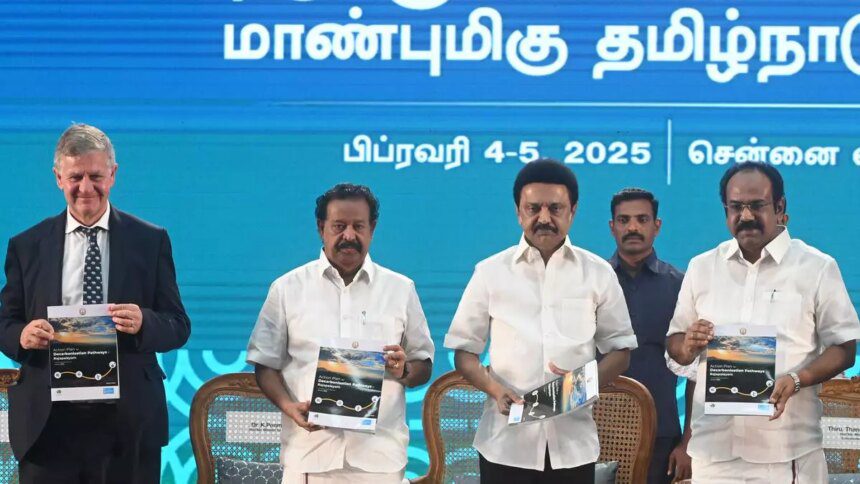When one thinks of Rajapalayam, the iconic Rajapalayam Hound often comes to mind, recognized as the Polygar Hound or Indian Ghost Hound, one of India’s distinguished dog breeds. However, in the near future, Rajapalayam is set to become synonymous with progressive initiatives such as ‘Climate Smart’ and ‘Carbon Neutral’ as the Tamil Nadu government launches a series of sustainable, climate-friendly measures for the region.
A comprehensive action plan is being developed to decarbonize Rajapalayam in southwestern Tamil Nadu, aiming to achieve carbon neutrality by 2041. This initiative will also include diverse strategies to foster climate resilience and promote smart climate practices in the town.
The Rajapalayam Local Planning Area (LPA) has the potential to serve as a ‘Model and Showcase’ town, a trendsetter for other towns across India aspiring to be both ‘Climate Smart’ and ‘Carbon Neutral,’ and with focused efforts, possibly even ‘carbon negative,’ as outlined in the Action Plan for Decarbonisation Pathways released by Tamil Nadu Chief Minister MK Stalin during the Tamil Nadu Climate Summit 3.0 in Chennai.
Currently, Rajapalayam stands as the largest consumer of energy and electricity in the region, accounting for about 70 percent of total regional consumption.
The action plan recommends several key strategies, including the conservation of Sanjeevi Malai, increasing urban green spaces, transitioning to clean energy sources, promoting sustainable transportation, and integrating climate resilience and adaptation measures to achieve low carbon development and sustainable economic growth.
Nestled near the Srivilliputhur Tiger Sanctuary and featuring the historically and religiously significant Sanjeevi Malai, Rajapalayam is rich in lush vegetation, which can be further enhanced to maximize its carbon sequestration potential. Additionally, the region is fortunate to have approximately 42 water bodies spread over 19.95 square kilometers, providing it with an inherent advantage, according to the report.
With its proximity to Thoothukudi and Tirunelveli, known for electricity generation via wind power, Rajapalayam is well-positioned to source green energy for its LPA and textile industry through effective wheeling of electricity from wind farms; many industries have already begun adopting this solution.
As of now, the greenhouse gas (GHG) emissions in Rajapalayam LPA are approximately 686,000 tonnes of CO2 equivalent, primarily resulting from electricity consumption, which constitutes around 64 percent of the region’s total GHG emissions as of 2021.
The waste sector also stands out as a significant emitter, including emissions from solid waste, domestic wastewater, and agricultural waste, accounting for about 20 percent of the total emissions. Other contributors include the transport and cooking sectors, as well as emissions from agriculture, particularly from rice cultivation.
Taking into account economic growth and projected population increases, it is estimated that by 2041, GHG emissions in Rajapalayam LPA could rise to approximately 777,000 tonnes of CO2 equivalent under a business-as-usual scenario. This estimation is based on historical emission trends and assumes that ongoing environmental policies from both the Government of India and the Government of Tamil Nadu will be effectively implemented to facilitate decarbonization.
Using this as the foundation, decarbonization pathways for Rajapalayam have been formulated, considering the decarbonization potential across various sectors and sub-sectors alongside their carbon sequestration capabilities, supplemented by the 2041 masterplan recently adopted by the Rajapalayam Municipality.
The immediate action plan identifies several priority areas, such as creating additional carbon sinks through eco-restoration projects in the Sanjeevi Malai corridor and urban spaces, addressing emissions from the waste sector, enhancing renewable energy deployment via ground-mounted solar arrays and solar rooftops on government and high-income buildings, and electrifying the public transport system.
“Rajapalayam is paving the way for small towns in India towards a greener future. The lovely city of Rajapalayam in Tamil Nadu is developing a master plan for a zero-carbon city, which is destined to inspire other cities both in India and worldwide,” stated Erik Solheim, a green politician and member of the Governing Council of the Tamil Nadu Climate Change Mission.
Rajapalayam, with a population of around 200,000, aims to harness solar energy, introduce 20-seat electric buses, restore water levels, plant trees, create parks, and implement many more initiatives. These efforts will transform it into a vibrant green, people-centered town, he remarked on social media.










